
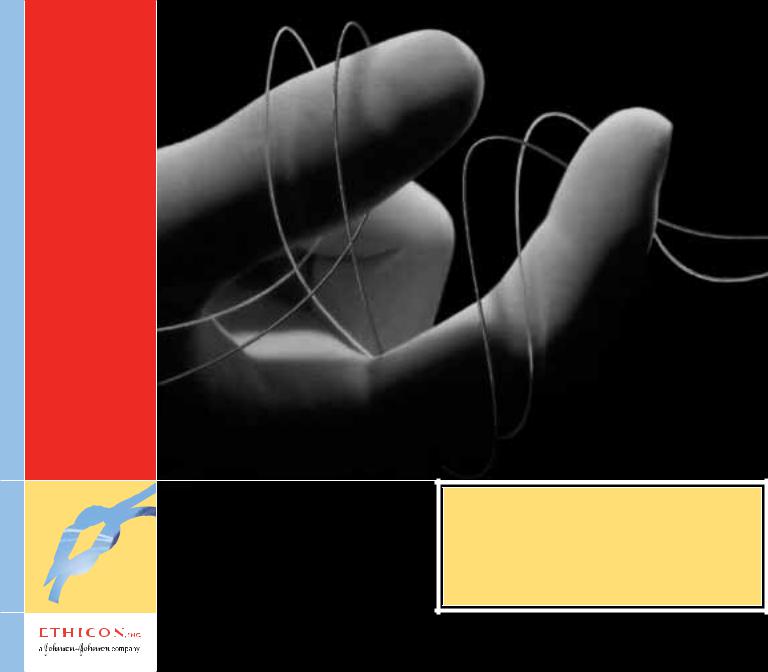
KN OT TY I N G
MA N UA L


SELECTED TERMS |
2 |
|
|
Absorption Rate Measures how quickly a suture is absorbed or broken down by the body. Refers only to the presence or absence of suture material and not to the amount of strength remaining in the suture.
Breaking Strength Retention (BSR) Measures tensile strength
(see below) retained by suture in vivo over time. For example, a suture with an initial tensile strength of 20 lbs. and 50% of its BSR at 1 week has 10 lbs. of tensile strength in vivo at 1 week.
Extensibility The characteristic of suture stretch during knot tying and recovery thereafter. Familiarity with suture’s extensibility will help the surgeon know when the suture knot is snug.
Memory Refers to a suture’s tendency to retain kinks or bends (set by the material’s extrusion process or packaging) instead of lying flat.
Monofilament Describes a suture made of a single strand or filament.
Multifilament Describes a suture made of several braided or twisted strands or filaments.
Tensile Strength The measured pounds of tension that a knotted
suture strand can withstand before breaking.
United States Pharmacopeia (USP) An organization that promotes the public health by establishing and disseminating officially recognized standards of quality and authoritative information for the use of medicines and other healthcare technologies by health professionals, patients, and consumers.

FOREWORD (PRACTICE BOARD†)
The KNOT TYING MANUAL and practice board are
available from ETHICON, INC., for all learners of suturing
and knot-tying techniques.
† Contributing Designer—Bashir Zikria, MD, FACS
Surgery draws upon all the sciences, but its very nature places it in the category of an art. Dexterity and speed in tying knots correctly constitute an art which only practice can make perfect.
Of the more than 1,400 different types of knots described in THE ENCYCLOPEDIA OF KNOTS, only a few are used in modern surgery. It is of paramount importance that each knot placed for approximation of tissues or ligation of vessels be perfect. It must hold with proper tension.
In the early days of surgery, materials were heavy and crude, knots bulky and inefficient. It was not unusual for the surgeon to place three or even four knots in the suture strand “just to be sure” it would hold.
Research and refinements of manufacture and sterilization have provided the surgeon of today with a wide choice of natural and synthetic suture materials. The successful use of any of these is dependent upon skillful knot tying and meticulous care in the handling of the suture. The adoption of finer gauge sutures has been accompanied by more refined, simplified and standardized suturing techniques.
It is the hope of ETHICON, INC., that this KNOT TYING MANUAL will help train medical students, surgical residents, physician assistants and others in the techniques of knot tying and the handling of sutures.
ETHICON, INC.
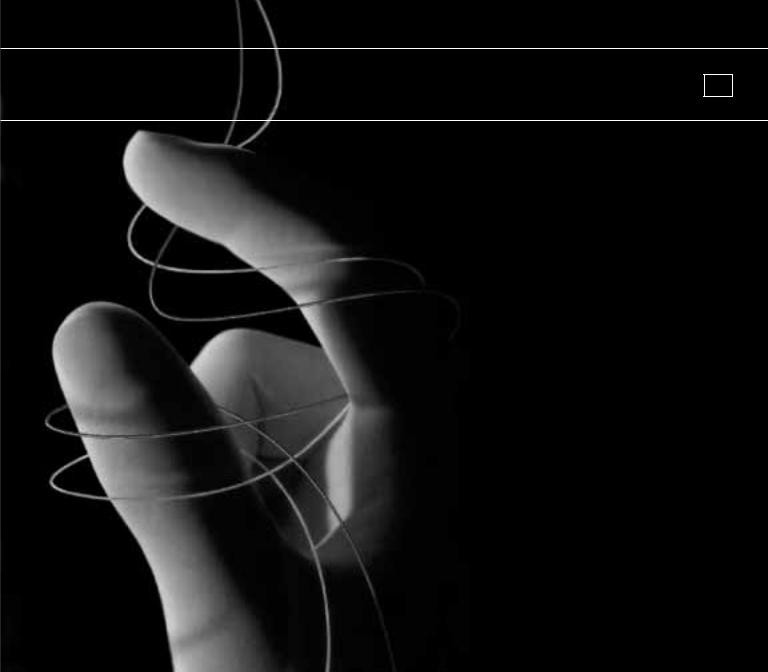
TABLE OF CONTENTS |
4 |
|
|
Foreword . . . . . . . . . . . . . . . . . . . . . . . . . . . . . . . . . . . . . . . . . . . . . . . . . . 3
Basic Knots . . . . . . . . . . . . . . . . . . . . . . . . . . . . . . . . . . . . . . . . . . . . . . . . 5
Knot Security . . . . . . . . . . . . . . . . . . . . . . . . . . . . . . . . . . . . . . . . . . . . . . . . . 5
General Principles of Knot Tying . . . . . . . . . . . . . . . . . . . . . . . . . . . . . . . . . . 6
Square Knot . . . . . . . . . . . . . . . . . . . . . . . . . . . . . . . . . . . . . . . . . . . . . . . . 7
Two-Hand Technique. . . . . . . . . . . . . . . . . . . . . . . . . . . . . . . . . . . . . . . . . . . . 7
One-Hand Technique. . . . . . . . . . . . . . . . . . . . . . . . . . . . . . . . . . . . . . . . . . . 13
Surgeon’s or Friction Knot . . . . . . . . . . . . . . . . . . . . . . . . . . . . . . . . . 17 DeepTie. . . . . . . . . . . . . . . . . . . . . . . . . . . . . . . . . . . . . . . . . . . . . . . . . . . 23 Ligation Around Hemostatic Clamp . . . . . . . . . . . . . . . . . . . . . . . . 27
More Common of Two Methods. . . . . . . . . . . . . . . . . . . . . . . . . . . . . . . . . 27
Alternate Technique . . . . . . . . . . . . . . . . . . . . . . . . . . . . . . . . . . . . . . . . . . . 29
InstrumentTie . . . . . . . . . . . . . . . . . . . . . . . . . . . . . . . . . . . . . . . . . . . . . 31
Granny Knot. . . . . . . . . . . . . . . . . . . . . . . . . . . . . . . . . . . . . . . . . . . . . . . 34
Suture Materials. . . . . . . . . . . . . . . . . . . . . . . . . . . . . . . . . . . . . . . . . . . 35
Principles of Suture Selection . . . . . . . . . . . . . . . . . . . . . . . . . . . . . 37
Surgical Needles . . . . . . . . . . . . . . . . . . . . . . . . . . . . . . . . . . . . . . . . . . 39
Trademarks. . . . . . . . . . . . . . . . . . . . . . . . . . . . . . . . . . . . . . . . . . . . . . . . 41
Notes . . . . . . . . . . . . . . . . . . . . . . . . . . . . . . . . . . . . . . . . . . . . . . . . . . . . . 42
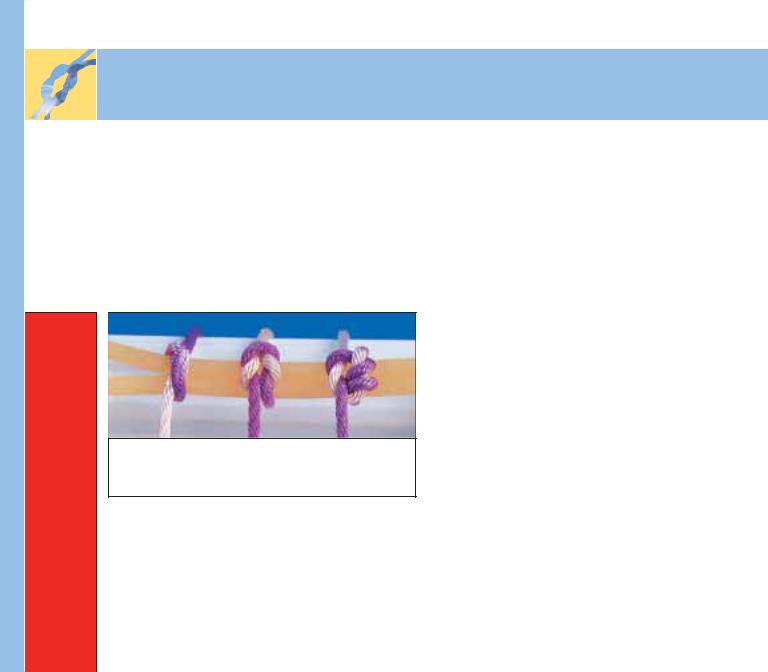
BASIC KNOTS
The knots demonstrated on the following pages are those most frequently used, and are applicable to all types of operative procedures. The camera was placed behind the demonstrator so that each step of the knot is shown as seen by the operator. For clarity, one half of the strand is purple and the other white. The purple working strand is initially held in the right hand. The left-handed person may choose to study the photographs in a mirror.
1.Simple knot: incomplete basic unit
2.Square knot: completed common knot
3.Surgeon’s or Friction knot: completed tension knot
KNOT SECURITY
The construction of ETHICON* sutures has been carefully designed to produce the optimum combination of strength, uniformity, and hand for each material. The term hand is
the most subtle of all suture quality aspects. It relates to
the feel of the suture in the surgeon’s hands, the smoothness with which it passes through tissue and ties down, the way
* Trademark
in which knots can be set and snugged down, and most of all, to the firmness of body of the suture. Extensibility relates to the way in which the suture will stretch slightly during knot tying and then recover. The stretching characteristics provide the signal that alerts the surgeon to the precise moment when the suture knot is snug.
Multifilament sutures are generally easier to handle and to tie than monofilament sutures; however, all the synthetic materials require a specific knotting technique. With multifilament sutures, the nature of the material and the braided or twisted construction provide a high coefficient of friction and the knots remain as they are laid down. In monofilament sutures, on the other hand, the coefficient of friction is relatively low, resulting in greater tendency for the knot to loosen after it has been tied. In addition, monofilament synthetic polymeric materials possess the property of memory. Memory is the tendency not to lie flat, but to return to given shape set by the material’s extrusion process or the suture’s packaging. The RELAY* suture delivery system delivers sutures with minimal package memory due to its unique package design.
Suture knots must be properly placed to be secure. Speed in tying knots may result in less than perfect placement of the strands. In addition to variables inherent in the suture
materials, considerable variation can be found between knots tied by different surgeons and even between knots tied by the same individual on different occasions.

6
GENERAL PRINCIPLES OF KNOT TYING
Certain general principles govern the tying of all knots and apply to all suture materials.
1.The completed knot must be firm, and so tied that slipping is virtually impossible. The simplest knot for the material is the most desirable.
2.The knot must be as small as possible to prevent an excessive amount of tissue reaction when absorbable sutures are used, or to minimize foreign body reaction to nonabsorbable sutures. Ends should be cut as short as possible.
3.In tying any knot, friction between strands (“sawing”) must be avoided as this can weaken the integrity of the suture.
4.Care should be taken to avoid damage to the suture material when handling. Avoid the crushing or crimping application of surgical instruments, such as needleholders and forceps, to the strand except when grasping the free end of the suture during an instrument tie.
5.Excessive tension applied by the surgeon will cause breaking of the suture and may cut tissue. Practice in avoiding excessive tension leads to successful use of finer gauge materials.
6.Sutures used for approximation should not be tied too tightly, because this may contribute to tissue strangulation.
7.After the first loop is tied, it is necessary to maintain traction on one end of the strand to avoid loosening of the throw if being tied under any tension.
8.Final tension on final throw should be as nearly horizontal as possible.
9.The surgeon should not hesitate to change stance or position in relation to the patient in order to place
a knot securely and flat.
10.Extra ties do not add to the strength of a properly tied knot. They only contribute to its bulk. With some
synthetic materials, knot security requires the standard surgical technique of flat and square ties with additional throws if indicated by surgical circumstance and the experience of the surgeon.
An important part of good suturing technique is correct method in knot tying. A seesaw motion, or the sawing of one strand down over another until the knot is formed, may materially weaken sutures to the point that they may break when the second throw is made or, even worse, in the postoperative period when the suture is further weakened by increased tension or motion.
If the two ends of the suture are pulled in opposite directions with uniform rate and tension, the knot may be tied more securely. This point is well illustrated in the knot tying techniques shown in the next section of this manual.
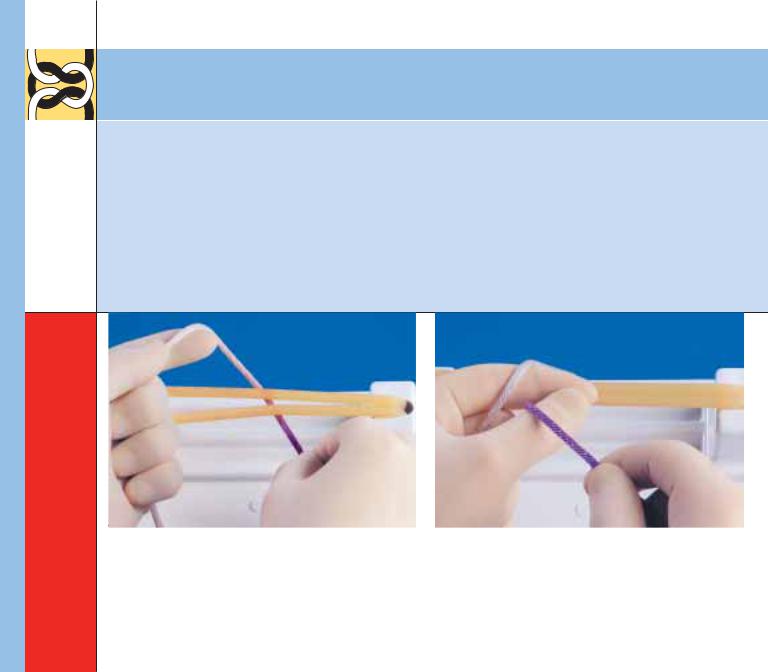
SQUARE KNOT |
TWO-HAND TECHNIQUE |
The two-hand square knot is the easiest and most reliable for tying most suture materials.
|
|
|
|
|
1 |
White strand placed over extended index |
2 |
Purple strand held in right hand brought |
|
finger of left hand acting as bridge, and held |
between left thumb and index finger. |
|||
in palm of left hand. Purple strand held in |
|
|||
right hand. |
|
|||
|
|
|
|
|
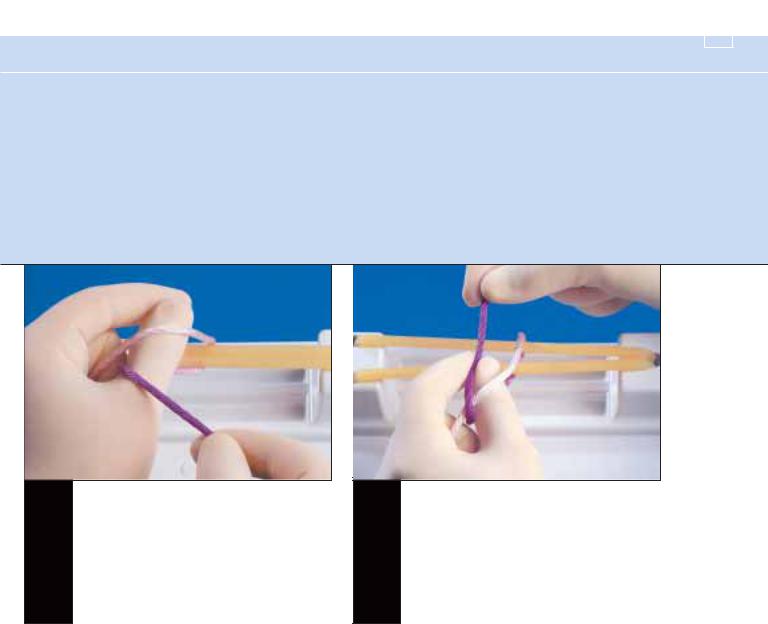
STEPS 1-4 |
18 |
|||
|
|
|
||
Standard technique of flat and square ties with additional |
|
suture, Coated VICRYL RAPIDE* (polyglactin 910) suture, |
||
throws if indicated by the surgical circumstance and the |
|
PDS* II (polydioxanone) suture, ETHILON* nylon suture, |
||
experience of the operator should be used to tie Coated VICRYL* |
|
ETHIBOND* EXCEL polyester suture, PERMA-HAND* silk suture, |
||
Plus Antibacterial (polyglactin 910) suture, Coated VICRYL* |
|
PRONOVA* poly (hexafluoropropylene-VDF) suture, |
||
(polyglactin 910) suture, MONOCRYL* (poliglecaprone 25) |
|
and PROLENE* polypropylene suture. |
||
|
|
|
|
|
|
|
|
|
|
3 |
Left hand turned inward by pronation, |
4 |
Purple strand crossed over white and held |
|
|
||
|
and thumb swung under white strand to |
|
between thumb and index finger of left hand. |
|
form first loop. |
|
|
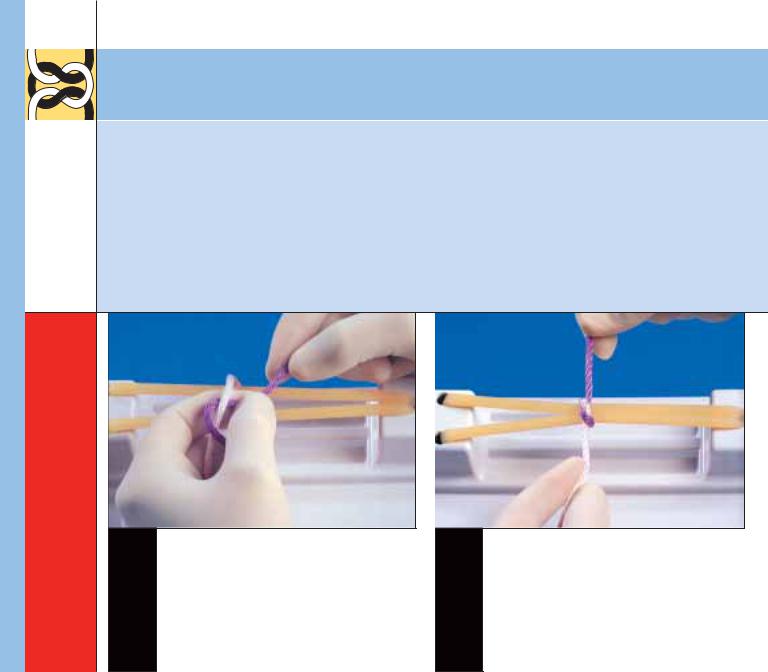
|
SQUARE KNOT |
|
TWO-HAND TECHNIQUE |
|
|
|
|
|
|
|
|
|
|
|
Right hand releases purple strand.Then left |
Purple strand released by left hand and |
hand supinated, with thumb and index finger |
grasped by right. Horizontal tension is |
still grasping purple strand, to bring purple |
applied with left hand toward and right |
5 strand through the white loop. Regrasp |
6 hand away from operator.This completes |
purple strand with right hand. |
first half hitch. |
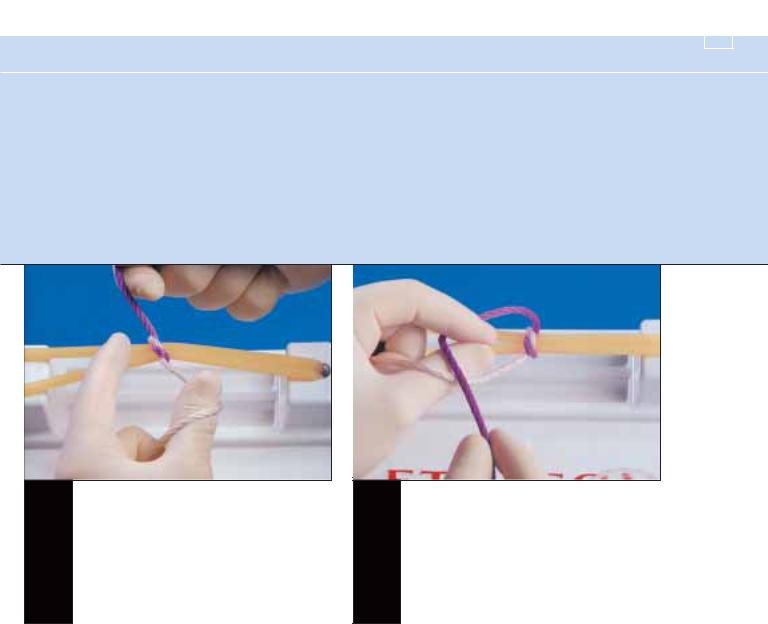
STEPS 5-8 |
10 |
|||
|
|
|
|
|
|
|
|
|
|
|
|
|
|
|
7 |
Left index finger released from white strand |
Purple strand held in right hand is angled |
and left hand again supinated to loop white |
slightly to the left. Purple strand brought |
|
strand over left thumb. |
toward the operator with the right hand and |
|
|
8 placed between left thumb and index finger. |
|
|
|
Purple strand crosses over white strand. |
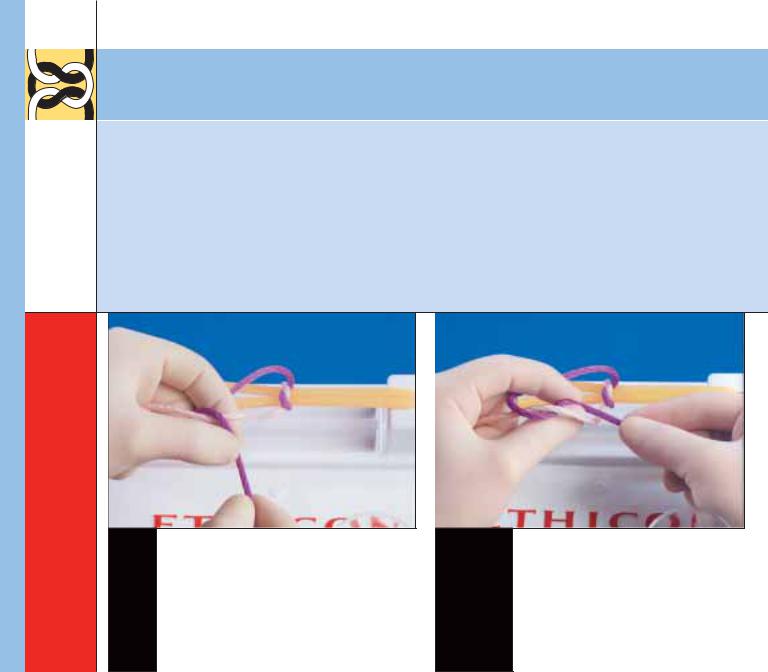
|
SQUARE KNOT |
|
TWO-HAND TECHNIQUE |
|
|
|
|
|
|
|
|
|
|
|
By further supinating left hand, white strand |
Left hand rotated inward by pronation |
slides onto left index finger to form a loop as |
with thumb carrying purple strand |
purple strand is grasped between left index |
through loop of white strand. Purple |
9 finger and thumb. |
10 strand is grasped between right thumb |
|
and index finger. |
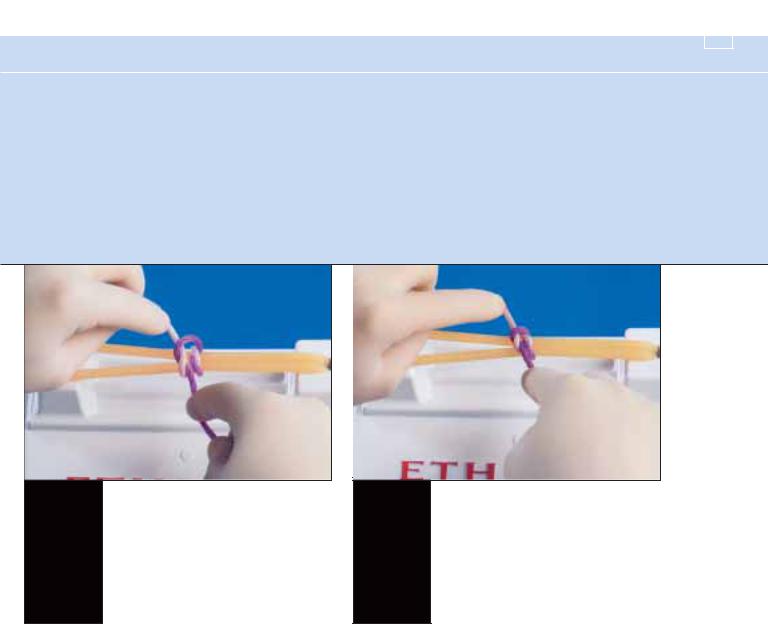
STEPS 9-12 |
12 |
|||
|
|
|
|
|
|
|
|
|
|
|
|
|
|
|
Horizontal tension applied with left |
12 |
The final tension on the final throw |
hand away from and right hand toward |
should be as nearly horizontal |
|
the operator.This completes the second |
as possible. |
|
11 half hitch. |
|
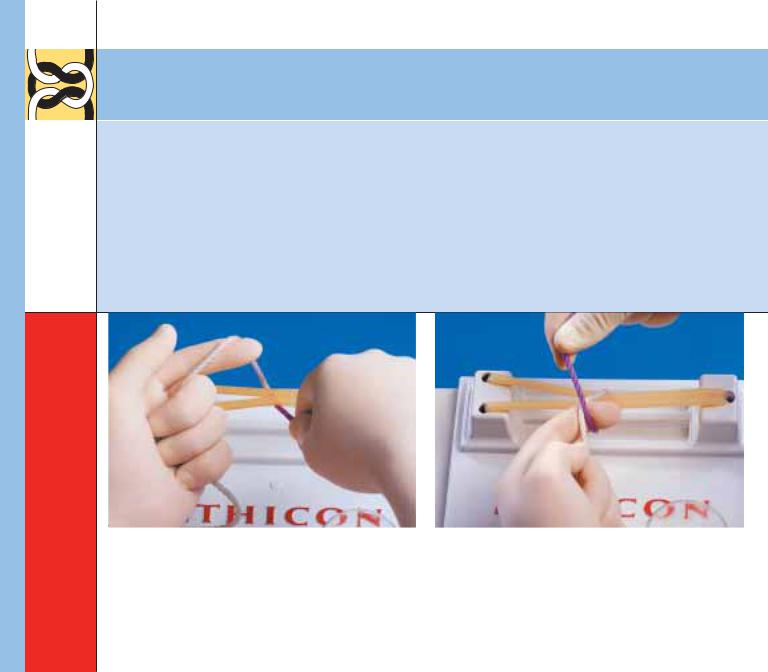
SQUARE KNOT |
ONE-HAND TECHNIQUE |
Wherever possible, the square knot is tied using the two-hand technique. On some occasions it will be necessary to use one hand, either the left or the right, to tie a square knot. These illustrations employ the left-handed technique.
|
|
|
|
|
1 |
White strand held between thumb and index |
2 |
Purple strand brought over white strand on |
|
finger of left hand with loop over extended |
left index finger by moving right hand away |
|||
index finger. Purple strand held between |
from operator. |
|||
thumb and index finger of right hand. |
|
|||
|
|
|
|
|
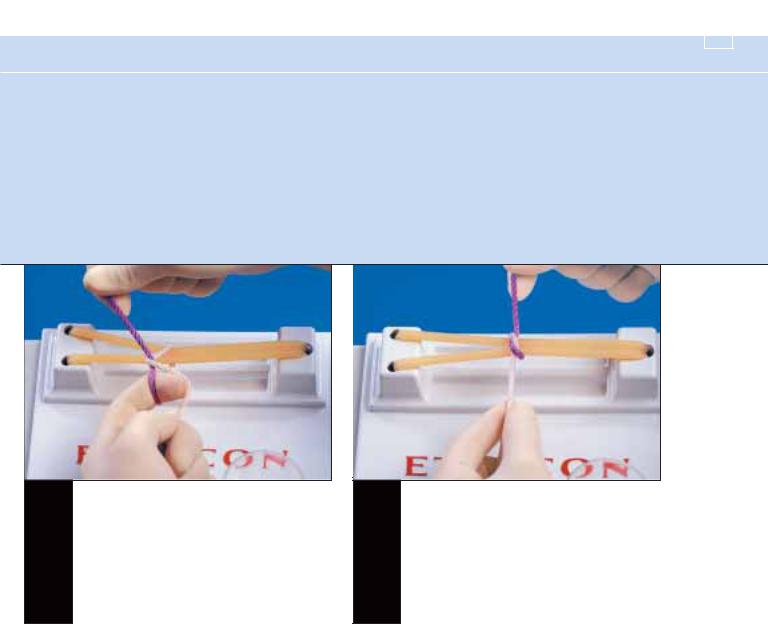
|
STEPS 1-4 |
14 |
||
|
|
|
||
The sequence of throws illustrated is most commonly used |
|
the directions the hands travel must be reversed proceeding |
||
for tying single suture strands. The sequence may be |
|
from one throw to the next to ensure that the knot formed |
||
reversed should the surgeon be holding a reel of suture |
|
lands flat and square. Half hitches result if this precaution is |
||
material in the right hand and placing a series of ligatures. |
|
not taken. |
||
In either case, it cannot be too strongly emphasized that |
|
|
|
|
|
|
|
|
|
|
|
|
|
|
With purple strand supported in right hand, |
The first half hitch is completed by advancing |
the distal phalanx of left index finger passes |
tension in the horizontal plane with the left |
under the white strand to place it over tip |
hand drawn toward and right hand away |
3 of left index finger.Then the white strand |
4 from the operator. |
is pulled through loop in preparation for |
|
applying tension. |
|
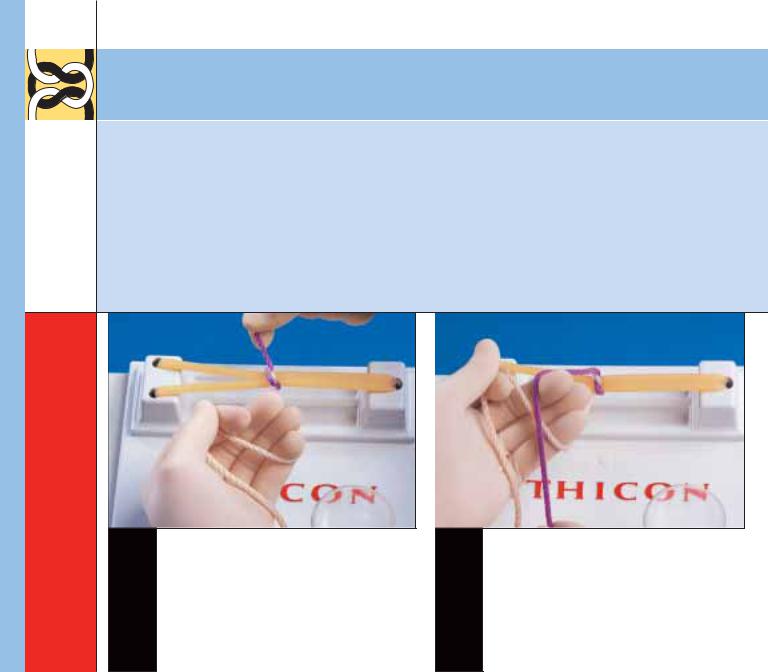
|
SQUARE KNOT |
|
ONE-HAND TECHNIQUE |
|
|
|
|
|
|
|
|
|
|
|
5 |
White strand looped around three fingers of |
Purple strand held in right hand brought |
left hand with distal end held between thumb |
toward the operator to cross over the white |
|
and index finger. |
strand. Continue hand motion by flexing |
|
|
6 distal phalanx of left middle finger to bring |
|
|
|
it beneath white strand. |
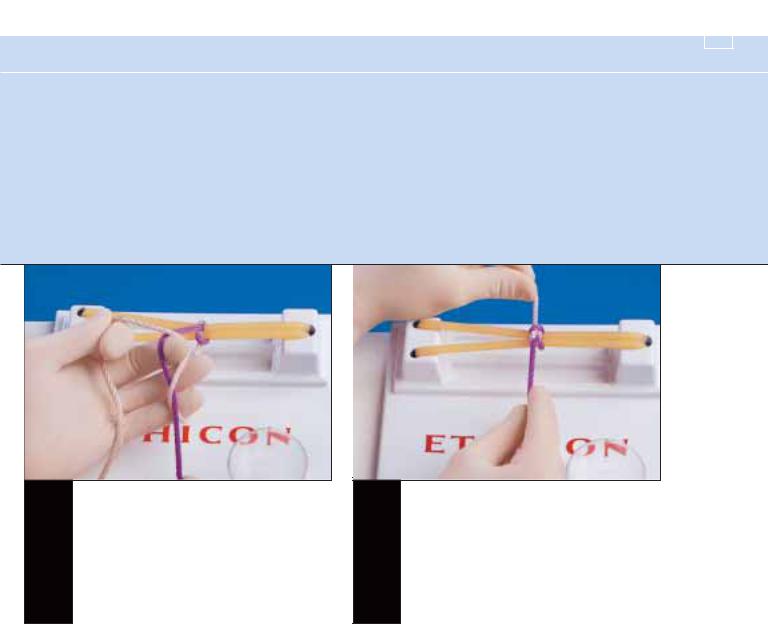
|
STEPS 5-8 |
16 |
||
|
|
|
|
|
|
|
|
|
|
|
|
|
|
|
7 |
As the middle finger is extended and the left |
Horizontal tension applied with the left hand |
hand pronated, the white strand is brought |
away from and the right hand toward the |
|
beneath the purple strand. |
operator.This completes the second half |
|
|
8 hitch of the square knot. Final tension should |
|
|
|
be as nearly horizontal as possible. |
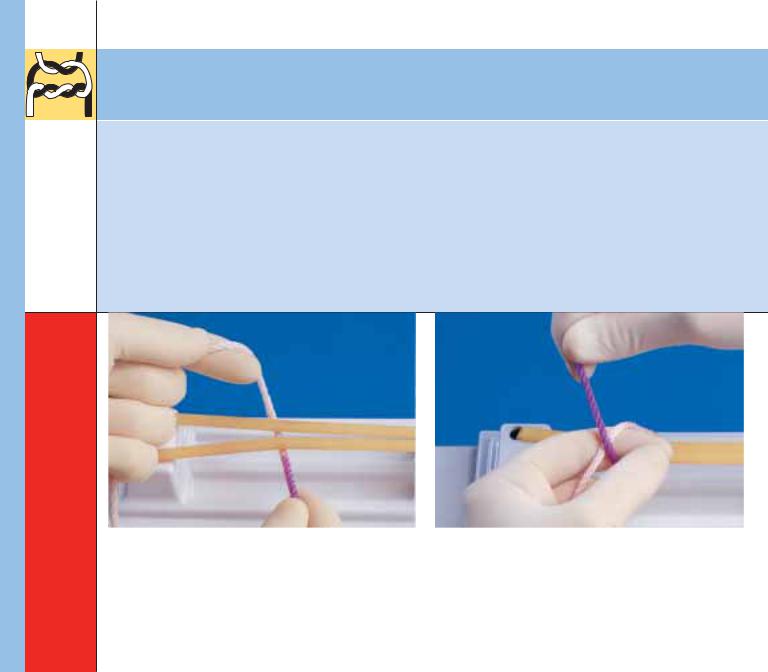
SURGEON’S OR FRICTION KNOT
|
|
|
|
|
1 |
White strand placed over extended index |
2 |
Purple strand crossed over white strand by |
|
finger of left hand and held in palm of left |
moving right hand away from operator at an |
|||
hand. Purple strand held between thumb and |
angle to the left.Thumb and index finger of |
|||
index finger of right hand. |
left hand pinched to form loop in the white |
|||
|
|
|
|
strand over index finger. |
|
|
|
|
|
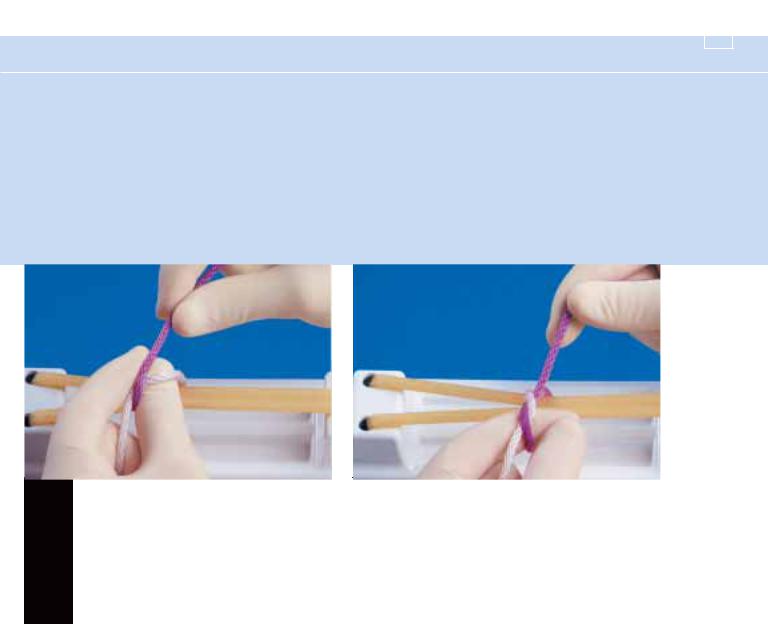
STEPS 1-4 |
18 |
|
|
The surgeon’s or friction knot is recommended for tying Coated VICRYL* Plus Antibacterial (polyglactin 910) suture, Coated VICRYL* (polyglactin 910) suture, ETHIBOND*
EXCEL polyester suture, ETHILON* nylon suture, MERSILENE* polyester fiber suture, NUROLON* nylon suture, PRONOVA* poly (hexafluoropropylene-VDF) suture, and PROLENE* polypropylene suture.
The surgeon’s knot also may be performed using a one-hand technique in a manner analogous to that illustrated for the square knot one-hand technique.
|
|
|
|
|
|
|
|
3 |
Left hand turned inward by pronation, and |
4 |
Left hand rotated by supination extending |
||
|
loop of white strand slipped onto left thumb. |
left index finger to pass purple strand |
||||
|
Purple strand grasped between thumb and |
through loop. Regrasp purple strand with |
||||
|
index finger of left hand. Release right hand. |
right hand. |
||||
|
|
|
|
|
|
|
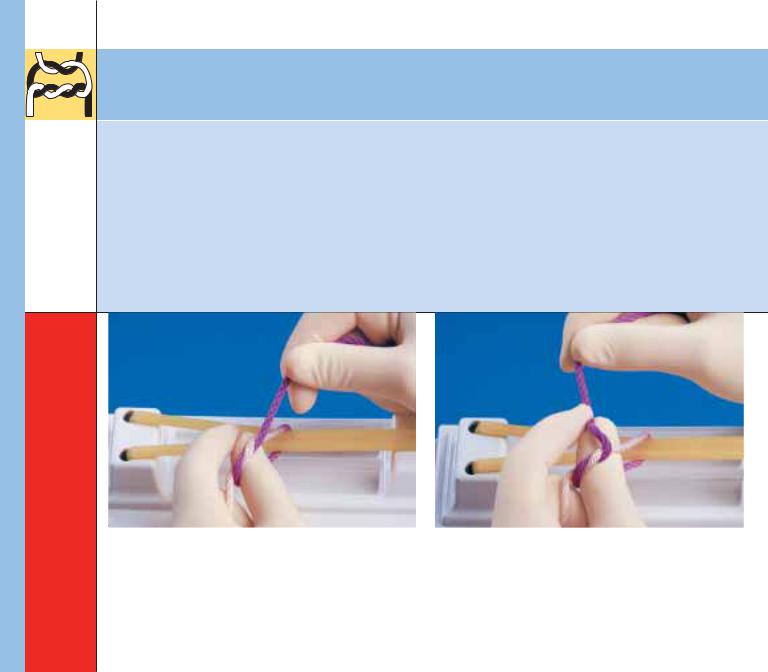
SURGEON’S OR FRICTION KNOT
|
|
|
|
|
5 |
The loop is slid onto the thumb of the left |
6 |
Purple strand drawn left with right hand |
|
|
|
|||
|
hand by pronating the pinched thumb and |
|
and again grasped between thumb and index |
|
|
index finger of left hand beneath the loop. |
|
finger of left hand. |
|
|
|
|
|
|
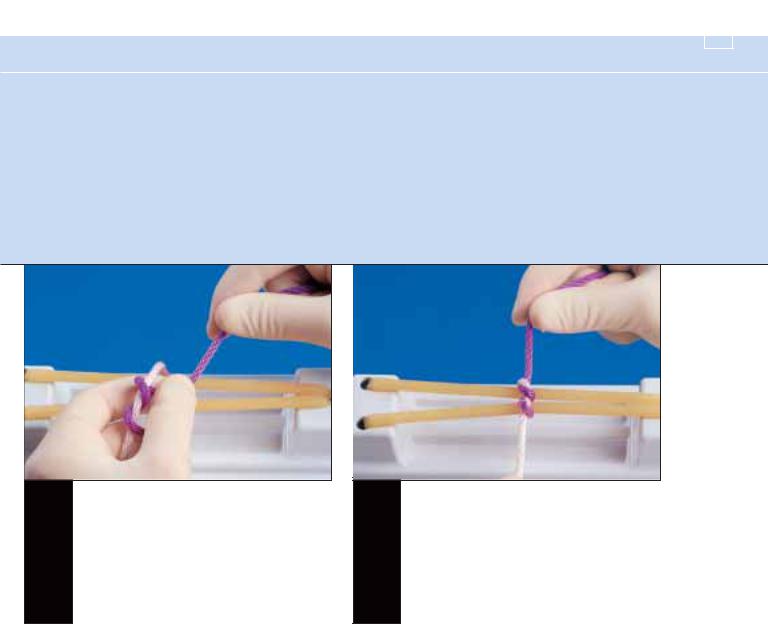
STEPS 5-8 |
201 |
|||
|
|
|
|
|
|
|
|
|
|
|
|
|
|
|
7 |
Left hand rotated by supination extending |
Horizontal tension is applied with left hand |
left index finger to again pass purple strand |
toward and right hand away from the |
|
through, forming a double loop. |
operator.This double loop must be placed in |
|
|
8 precise position for the final knot. |
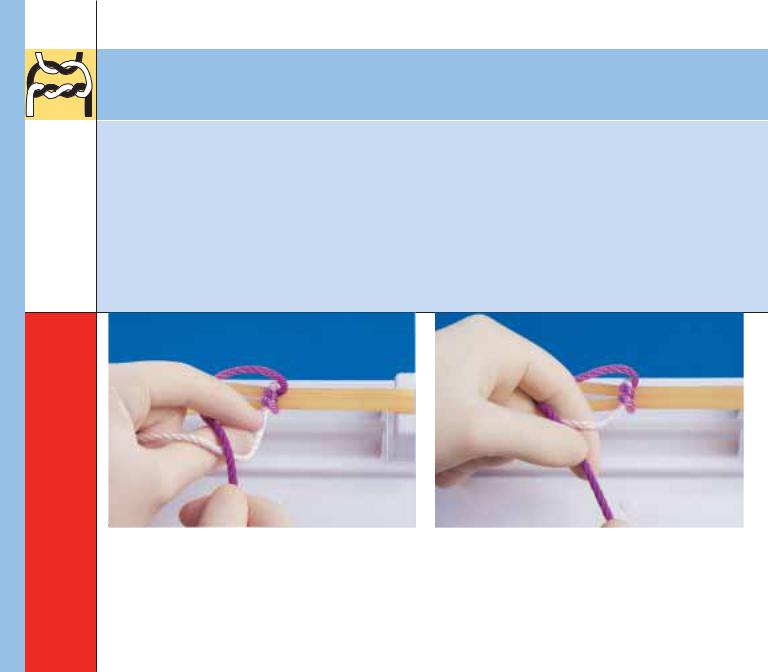
SURGEON’S OR FRICTION KNOT
|
|
|
|
|
9 |
With thumb swung under white strand, |
|
10 |
Purple strand released. Left hand |
purple strand is grasped between thumb |
|
supinates to regrasp purple strand with |
||
and index finger of left hand and held over |
|
index finger beneath the loop of the |
||
white strand with right hand. |
|
white strand. |
||
|
|
|
|
|
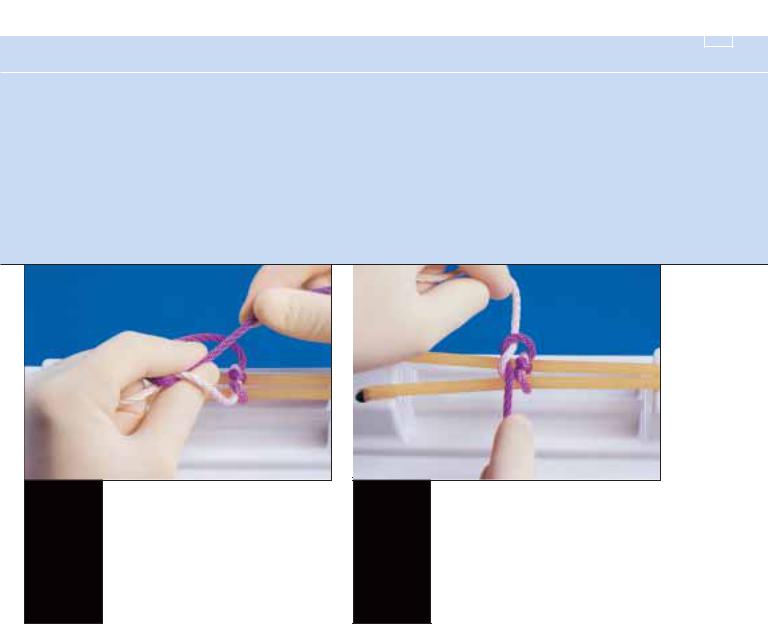
STEPS 9-12 |
22 |
|||
1 |
||||
|
|
|
|
|
|
|
|
|
|
|
|
|
|
|
Purple strand rotated beneath the white |
Hands continue to apply horizontal |
strand by supinating pinched thumb |
tension with left hand away from and |
and index finger of left hand to draw |
right hand toward the operator. Final |
11 purple strand through the loop. |
12 tension on final throw should be as |
Right hand regrasps purple strand to |
nearly horizontal as possible. |
complete the second throw square. |
|
